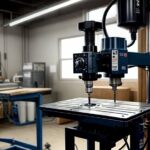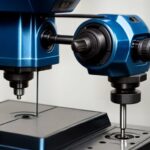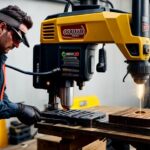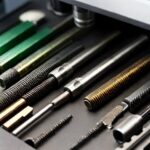Drill presses are crucial for woodworking, metalworking, and other production processes. They can create accurate holes that are difficult or impossible to construct by hand. Yet, how can you determine which is best with so many drill presses available?
Understanding the many measures used to characterize drill presses is key to the solution. In this post, we’ll look at the essential metrics for evaluating drill presses, such as swing, throat depth, horsepower, and chuck size.
We’ll also advise on choosing the best drill press for your requirements. This tutorial will help you understand how drill presses are measured and what to look for when purchasing the correct one for your workshop, whether you’re a professional machinist or a DIY enthusiast.
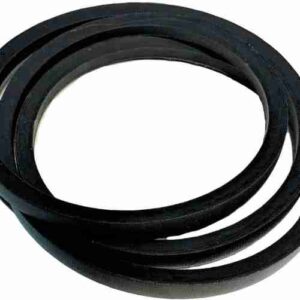 Drill Press Measurements:
Drill Press Measurements:
A. How do you measure the drill press belt?
- Find the belt: The belt is positioned near the engine on the top of the drill press. Check for the synthetic or rubber material that wraps around the pulleys.
- Determine the belt’s length: With a measuring tape, determine the length of the belt. Put the tape at the bottom of the belt and run it until you reach the other end.
- Decide the belt width: The width of the belt will vary based on the type of drill press. Using a ruler or caliper, determine the width of the belt.
- After you’ve decided on the length and breadth of the belt, write down the dimensions in inches or millimeters. This dimension will assist you in selecting the correct replacement belt for your drill press.
- Select a replacement belt: When you’ve measured the length and breadth of the belt, look for a belt that fits those parameters. Search for belts that are made particularly for your drill press model.
B. How to measure drill press swing?
- Determine the chuck’s center: The chuck’s center is where the drill bit spins. Open the chuck jaws and peek inside to identify the center. A little point or a line should indicate the center.
- Determine the distance between the chuck’s center and the closest edge of the support column: The support column is the vertical element that holds the drill head. Measure the distance from the center of the chuck to the closest edge of the support column using a measuring tape. The radius of the swing is this distance.
- Double the radius to find the swing: After measuring the radius, twice that distance to determine the drill press’s swing. The swing is the greatest distance between the chuck’s center and the support column.
- Measure the swing: After establishing it, measure it in inches or millimeters. This measurement will assist you in selecting the best drill press for your requirements.
C. How do you measure the throat depth of a drill press?
- Determine the throat depth: The depth is the distance from the spindle’s center to the front of the column. It is usually mentioned in the drill press specs, but you may measure it yourself if you can’t find it there.
- Put a straight edge against the column: Set a straight edge against the front, such as a ruler or wood. Check that the straight edge is flat with the column.
- Using a measuring tape, determine the distance between the straight edge and the spindle’s center. This distance represents the neck depth.
- Record the measurement: After determining the neck depth, write it down in inches or millimeters. This measurement will assist you in selecting the best drill press for your requirements.
D. How do you measure drill press horsepower?
- Identify the motor: The drill press’s motor is usually positioned at the top or rear of the machine.
- Find the motor plate: The motor plate is a metal plate connected to the motor that contains vital information about the motor’s specs, such as its horsepower rating.
- Examine the motor plate: Look for the horsepower rating on the motor plate. It is commonly expressed in horsepower (HP) or watts (W). If the rating is in watts, use the following formula to convert it to horsepower: 1 HP = 746 W.
- Examine the manufacturer’s specs: In addition to the motor plate, you may check the drill press’s manufacturer’s specifications to establish its horsepower rating.
- Record the measurement: After discovering the drill press’s horsepower rating, write it down in horsepower or watts. This measurement will assist you in selecting the best drill press for your requirements.
E. How to measure drill press Chuck size?
- Open the chuck: With the chuck key, open the chuck jaws to their widest position.
- Measure the diameter of the opening using a measuring tape or caliper: Measure the diameter of the opening where the drill bit is inserted with a measuring tape or caliper. To get an accurate measurement, measure across the middle of the aperture.
- Take a measurement: After calculating the diameter of the entrance, write it down in inches or millimeters. This is the size of the chuck.
- Verify the manufacturer’s specs: In addition to measuring the chuck size, you may ascertain the chuck size by consulting the drill press’s manufacturer’s specifications. This information might also be printed on the drill press.
- When you decide on the chuck size, you may choose the appropriate drill bit for your project. Use a drill bit smaller than the chuck size to achieve a snug fit.
Frequently Asked Questions (FAQs)
1. What is the swing of a drill press, and why is it important?
The swing of a drill press refers to the maximum distance between the center of the chuck and the support column. It is important because it determines the largest size of material that can be drilled on the drill press. A larger swing allows you to work with bigger workpieces.
2. How do I determine the horsepower of my drill press?
You can determine the horsepower of your drill press by checking the motor plate or the manufacturer’s specifications. The motor plate is a metal plate attached to the motor that contains important information about the motor’s specs, including its horsepower rating. The manufacturer’s specifications can be found in the user manual or on the manufacturer’s website.
3. Can I use a drill press for milling?
While it is possible to convert a drill press into a milling machine, it is not recommended. Drill presses are designed for drilling operations, and milling requires a more rigid and stable machine. Converting a drill press into a milling machine may result in poor milling results and could damage the drill press.
4. What is the difference between a benchtop and a floor-standing drill press?
A benchtop drill press is a smaller, more compact version of a drill press designed to be mounted on a workbench or table. A floor-standing drill press, also known as a floor model, is a larger, more powerful machine that stands on the floor and typically has a larger swing and throat depth. The choice between the two depends on your workspace and the type of projects you plan to work on.
5. How do I maintain my drill press?
Maintaining your drill press involves regular cleaning, lubrication, and inspection. Keep the drill press free of dust and debris, lubricate moving parts with appropriate lubricants, and inspect belts, pulleys, and other components for wear and tear. Regular maintenance will ensure the longevity and performance of your drill press.
6. Can I use a drill press for woodworking as well as metalworking?
Yes, a drill press can be used for both woodworking and metalworking projects. However, it is essential to use the appropriate drill bits and cutting speeds for each material. Using the correct drill bits and adjusting the speed settings will ensure optimal performance and prevent damage to the drill press and workpieces.
Final words:
Finally, knowing the many metrics used to assess drill presses is critical for picking the best equipment for your requirements. Swing, throat depth, horsepower, and chuck size are major metrics used to define drill presses.
You may quickly measure the important characteristics of a drill press and pick the machine most suited to your requirements by following the step-by-step instructions for each measurement.
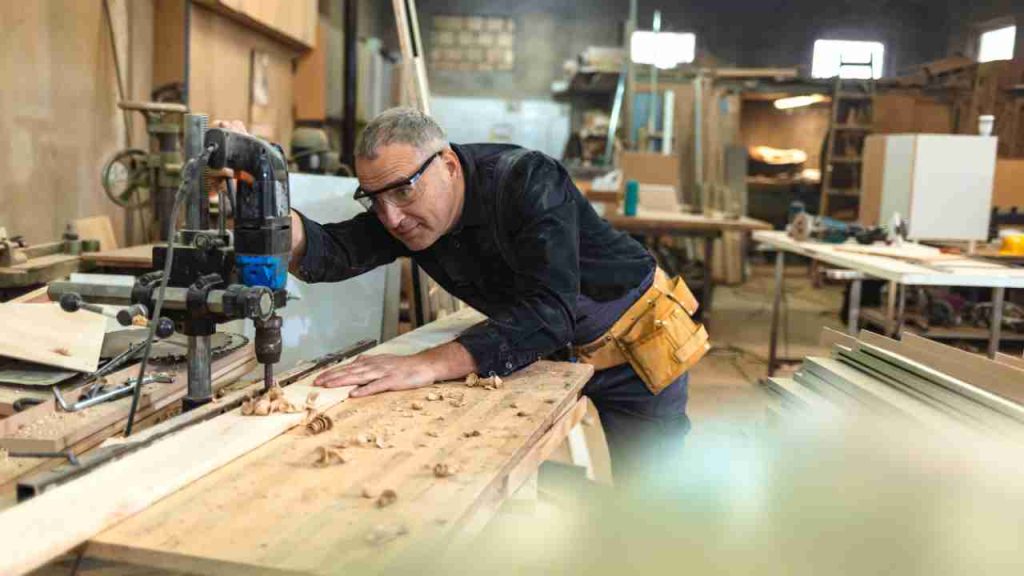
Investing in the proper drill press may make or break the quality of your job. You may be certain that you are making the best option for your workshop if you understand how drill presses are measured and what to look for when purchasing a machine. We hope this advice has been useful in your search for the best drill press for your requirements.
- Where are WEN drill presses made? - April 2, 2023
- Where are Rikon drill presses made? - April 1, 2023
- Where are Powermatic drill presses made? - April 1, 2023


